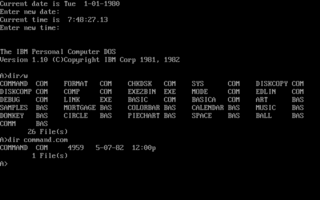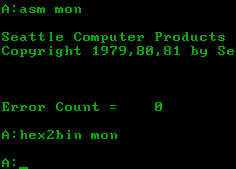
IBM PC DOS, an acronym for IBM personal computer disk operating system, also known as IBM Personal Computer DOS, is a discontinued operating system for the IBM Personal Computer, manufactured and sold by IBM from the early 1980s into the 2000s.

86-DOS is a discontinued operating system developed and marketed by Seattle Computer Products (SCP) for its Intel 8086-based computer kit. Initially known as QDOS, the name was changed to 86-DOS once SCP started licensing the operating system in 1980.
Tim Paterson is an American computer programmer, best known for creating 86-DOS, an operating system for the Intel 8086. This system emulated the application programming interface (API) of CP/M, which was created by Gary Kildall. 86-DOS later formed the basis of MS-DOS, the most widely used personal computer operating system in the 1980s.
In computing, the DOS Protected Mode Interface (DPMI) is a specification introduced in 1989 which allows a DOS program to run in protected mode, giving access to many features of the new PC processors of the time not available in real mode. It was initially developed by Microsoft for Windows 3.0, although Microsoft later turned control of the specification over to an industry committee with open membership. Almost all modern DOS extenders are based on DPMI and allow DOS programs to address all memory available in the PC and to run in protected mode.

A bootloader, also spelled as boot loader or called boot manager and bootstrap loader, is a computer program that is responsible for booting a computer.
A File Control Block (FCB) is a file system structure in which the state of an open file is maintained. A FCB is managed by the operating system, but it resides in the memory of the program that uses the file, not in operating system memory. This allows a process to have as many files open at one time as it wants to, provided it can spare enough memory for an FCB per file.
IO.SYS is an essential part of MS-DOS and Windows 9x. It contains the default MS-DOS device drivers and the DOS initialization program.

PC Magazine is an American computer magazine published by Ziff Davis. A print edition was published from 1982 to January 2009. Publication of online editions started in late 1994 and continues to this day.
This article details versions of MS-DOS, IBM PC DOS, and at least partially compatible disk operating systems. It does not include the many other operating systems called "DOS" which are unrelated to IBM PC compatibles.
Jeff Prosise is a technical author on Microsoft Windows applications. He is very experienced in Microsoft Windows technologies like MFC, .NET Framework, C# and others.
Marc B. McDonald is an American who was Microsoft's first salaried employee.
Epsilon is a programmer's text editor modelled after Emacs. It resembles Emacs not only in its default keybindings and layout, but also in the fact that it has a Turing-complete extension language in which much of its functionality is implemented. Unlike Emacs, Epsilon's extension language, EEL is a dialect of C rather than a dialect of Lisp. Epsilon runs on DOS, Microsoft Windows, Linux, FreeBSD, Mac OS X and OS/2.
In computing, sys is a command used in many operating system command-line shells and also in Microsoft BASIC.
The DOS API is an API which originated with 86-DOS and is used in MS-DOS/PC DOS and other DOS-compatible operating systems. Most calls to the DOS API are invoked using software interrupt 21h. By calling INT 21h with a subfunction number in the AH processor register and other parameters in other registers, various DOS services can be invoked. These include handling keyboard input, video output, disk file access, program execution, memory allocation, and various other activities. In the late 1980s, DOS extenders along with the DOS Protected Mode Interface (DPMI) allow the programs to run in either 16-bit or 32-bit protected mode and still have access to the DOS API.
This article presents a timeline of events in the history of 16-bit x86 DOS-family disk operating systems from 1980 to 2020. Non-x86 operating systems named "DOS" are not part of the scope of this timeline.

MS-DOS is an operating system for x86-based personal computers mostly developed by Microsoft. Collectively, MS-DOS, its rebranding as IBM PC DOS, and few operating systems attempting to be compatible with MS-DOS, are sometimes referred to as "DOS". MS-DOS was the main operating system for IBM PC compatible personal computers during the 1980s, from which point it was gradually superseded by operating systems offering a graphical user interface (GUI), in various generations of the graphical Microsoft Windows operating system.
Control-Alt-Delete is a computer keyboard command on IBM PC compatible computers, invoked by pressing the Delete key while holding the Control and Alt keys: Ctrl+Alt+Delete. The function of the key combination differs depending on the context but it generally interrupts or facilitates interrupting a function. For instance, in pre-boot environment or in DOS, Windows 3.0 and earlier versions of Windows or OS/2, the key combination reboots the computer. Starting with Windows 95, the key combination invokes a task manager or security related component that facilitates ending a Windows session or killing a frozen application.

Software is a set of programmed instructions stored in the memory of stored-program digital computers for execution by the processor. Software is a recent development in human history, and it is fundamental to the Information Age.





